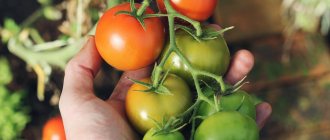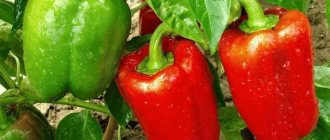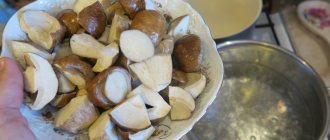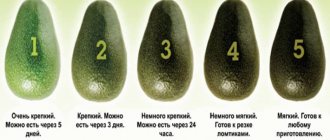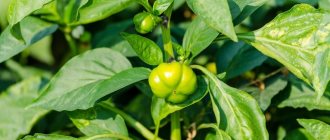Why do tomatoes not turn red for a long time in the garden, in the greenhouse and on the balcony?
The approximate time it takes for tomatoes to ripen after the start of flowering is 40-55 days . The exact period depends on the type of vegetable crop.
During the first month, the green fruits increase in size and become dense. After this, they need about 20 more days to ripen.
There are several reasons why tomatoes ripen more slowly in a greenhouse, open ground and on the balcony:
- Lighting . How the tomatoes turn red will depend on the lighting in the room. If there is not enough light for the fruits, they will develop unevenly and slowly. In open ground, ripening is slowed down by cloudy weather.
- Nutrition . If the fertilizing was incorrect (for example, with an excess of nitrogen), the stems become large and the fruits become small and may not turn red for a long time.
- Temperature . If the temperature is too low or too high, tomatoes will not grow as well. They do not produce the pigment lycopene, which gives tomatoes their red color. The optimal temperature for tomato growth is +15…+35°C.
Features of accelerating ripening in a greenhouse and in open ground
To speed up the ripening process of tomatoes in open ground , adhere to the following rules:
- If cold dew falls at night, cover the tomatoes with foil overnight. This will protect the fruits from moisture and reduce the likelihood of late blight.
- It is better to remove brown tomatoes so that they ripen elsewhere.
- Spray the plants with iodine solution - this will strengthen the immune system.
- Remove the lower leaves of the plant up to the clusters where the fruits are already ripening.
If tomatoes grow in a greenhouse , these rules apply to them. However, if the greenhouse has heating, then it is recommended to leave no more than 12 brushes on the plant. If there is no heating, then no more than 7.
In greenhouse conditions, before the onset of cold weather, the fruits on the middle clusters are fully ripened, and on the tops - partially.
Experienced gardeners recommend removing the shoots and leaving no more than 17 leaves on the plant.
Conditions for ripening and storing green tomatoes
For the best results in preserving tomatoes, certain conditions must be observed. Let's look at detailed instructions on where and how to keep tomatoes, as well as unusual methods and tips for preserving the harvest.
Where is the best place to store harvested unripe tomatoes?
For quick ripening, the best place is a dark and warm room with a moderate level of humidity. It should be well ventilated. The optimal temperature is +…+25°C, the higher it is, the faster the tomatoes will ripen.
There are several options for storage:
- Small boxes are covered with paper (not newspaper), and tomatoes are laid out in a maximum of 3 layers. Each subsequent layer is also covered with paper. Instead of paper, you can sprinkle the fruits with straw or sawdust.
- Storage in banks. The jars are first sterilized, 2 tbsp are poured into the bottom. l. dry mustard. Unripe tomatoes are laid out in layers. Each layer is also sprinkled with mustard. Roll up with a metal lid. Place the jars for storage in a dark, cool place: a basement or cellar is ideal. Tomatoes will remain fresh for up to 4-5 months.
- In a small apartment, you can spread a cloth under the bed and scatter unripe tomato berries on it, covering them with another cloth.
Previously, unripe tomatoes were stored in felt boots . This is also a valid option, but you will have to go through them every 2-3 days, keeping track of the ripe ones and those that have begun to deteriorate.
Feeding tomatoes for early ripening
Methods for accelerating the ripening of tomatoes are used only if the timing is appropriate and the number of ripe fruits is insufficient . In many regions of our country, this is relevant for the last summer months: from the end of July to the end of August.
Proper feeding plays an important role. For rapid ripening, it is necessary that tomatoes receive the required amount of nitrogen, phosphorus, potassium, calcium, magnesium and sodium.
Experienced gardeners recommend combining organic and mineral fertilizers. With this approach, tomatoes not only grow faster, but also bear fruit more abundantly.
Feeding with iodine
Iodine is a traditional fertilizer that gardeners use to feed tomatoes . It solves two problems at once: prevention of fungal infections and feeding. Thanks to iodine, nitrogen metabolism in the soil improves and resistance to various infections increases, the plant begins to bear fruit better.
Lack of iodine leads to reduced yields and incomplete ripening of fruits.
Reference. Tomatoes are watered with iodine solution in a ratio of 1 drop of the substance per 3 liters of warm water.
Feeding with ash
Ash is an effective tool for strengthening the root system and protecting against pests . It is rich in nutrients necessary for the growth and development of the plant. Ash contains phosphorus, potassium, nitrogen, sodium, calcium and magnesium.
The infusion is prepared as follows: a glass of ash is dissolved in 5 liters of water. The solution is infused for a week. After this, the tomatoes can be watered.
Watering with potassium humate
Humate is a mixture of salts of various microelements and acids . Fertilizer is formed due to organic deposits. Humate improves air penetration into the soil, kills microbes, and neutralizes toxins.
Potassium humate is an excellent organic fertilizer for tomatoes: it increases productivity and makes the roots stronger. For feeding, use a solution with a concentration of 0.05%. 2 liters of the substance are distributed per 1 m² of soil.
How to speed up the ripening of tomatoes in open ground
At the end of July and beginning of August, cold dew falls in the morning. To avoid late blight in tomatoes, you can install arcs and pull on the covering material. The shelter will allow you to maintain a certain temperature, which will allow the tomatoes to ripen to milky maturity.
Turning the brushes towards the sun. Remove unnecessary leaves, place wooden supports under the tomato trusses so that the fruits do not lie on the ground, and turn the trusses towards the sun.
We have already discussed above that ethylene contributes to the reddening of tomatoes. We use this technique for open ground. One ripe, already picked red tomato is fixed onto a bunch of green tomatoes. A transparent plastic bag is placed over this bunch. Ethylene, which is released by a ripe tomato, will accelerate the ripening of tomatoes.
Additional ways to make tomatoes turn red
If you have followed all the care recommendations, but the fruits have not started to turn red, try additional ways to speed up the ripening of tomatoes.
Removing new flower stalks
To have large and sweet tomatoes, remove new buds and flowers that form on the tops of the bushes. The young fruits will no longer be able to ripen, and the bush’s strength will be taken away, which will slow down the development process of the remaining tomatoes.
Trim the tops of tall bushes and remove all inflorescences. If the bushes are short and medium-sized, then all flower brushes that interfere with the normal development of fruits are also cut off on them.
Stepsoning
Another way to stimulate the growth of tomatoes is pinching.
The plant branches well, forming stepsons (side shoots). Flower clusters appear on new shoots. After the extra shoots are removed, the plant does not waste energy on the extra shoots, and its energy is directed to ripening the fruits.
Food restriction
To grow tomatoes, many experienced gardeners use forced food restriction .
An incision is made in the stem (12 cm from the ground) and a thin wooden plate (10-15 mm) is placed in the gap that has formed. Thanks to this, not only the flow of nutrients into the plant is controlled, but also their outflow.
After using this method, tomatoes begin to ripen much faster.
How quickly does the method work?
The method is effective and time-tested; it is used by many gardeners. But in terms of timing, everything is a little more complicated.
The procedure should be performed about a month before the moment when they should ripen on their own. That is, within two weeks after using this method, the tomatoes will turn red.
There is no point in using this method in advance. For example, if tomatoes are available only in August, there is no point in giving them vodka; the process will not speed up much.
It is important to wait for the moment when they begin to gain color on their own. And even if the tomato has just started to turn red, you can try this method.
The main thing is to remember which bush undergoes such treatment. After harvesting, no one will be able to taste the difference in taste. Also, don’t worry about the presence of vodka, it will no longer be in the tomato.
Reproduction of this material is prohibited.
Due to the high content of the “happiness hormone” - serotonin - tomatoes improve your mood no worse than chocolate. They are good for heart health, youthful skin and strong bones.
Almost every summer resident grows them - mainly in greenhouses. But even under favorable conditions, tomatoes do not always have time to ripen. In this article we will tell you what to do to make tomatoes in a greenhouse turn red faster.
Why do tomatoes picked from the bush not ripen?
Why don't tomatoes turn red when picked from the bush? There are several reasons for this :
- low room temperature;
- tomatoes are picked early from the bush (before the first phase of ripening);
- lack of lighting.
To make tomatoes pour faster , you can add already ripened fruits to them. They will help others acquire the red color faster.
Why does a tomato turn red with green spots near the stalk?
If the temperature is higher or lower than normal values , then not only the fruits slow down in the ripening process, but also a green-yellow edging appears on the tomato stalk.
The concentration of the coloring pigment lycopene in fruits decreases, and therefore the uneven redness of tomatoes disappears.
Important! To avoid a sharp temperature change between day and night, it is necessary to ventilate the greenhouse during the day and turn on the heating at night.
How to make tomatoes ripen quickly
The optimal temperature for rapid ripening is considered to be +22-26°C . To maintain this regime in hot weather, the greenhouse is ventilated all day. Be sure to close it at night and turn on the heater when it gets cold.
A lot of light is needed. Seedlings are planted at a distance of at least 40 cm from each other. When forming a bush, always remove the lower leaves and stepsons, which interfere with the receipt of light and nutrition. In August the top is pinched off. Daylight hours should last at least 15 hours. If it is shorter, provide additional lighting.
In July and August, all bushes are sprayed from bottom to top with a weak solution of iodine, and potassium humate is poured under the root every 10 days. It is also effective to spray brushes with ovaries and leaves with a superphosphate extract.
The first tomatoes - both small and large - are picked at the stage of partial ripening , when the flesh inside is pink.
You can inject 0.5 ml of alcohol once into green greenhouse vegetables to accelerate redness.
Experienced gardeners use the method of pulling or injuring the stem.
If the summer is not hot, from the second half of July some gardeners deliberately stop watering and fertilizing tomato beds in the greenhouse.
Ripening of fruits with signs of late blight
Tomatoes are susceptible to late blight. The disease manifests itself in blackening of the fruits and leaves of the plant and negatively affects the yield. Late blight most often appears in the second half of summer. Cold and dampness are favorable conditions for the development of fungus.
eat tomatoes that suffer from late blight , but they must be processed. Within 15 seconds, the fruits are placed in water at a temperature of at least 60°C. Next, the tomatoes are dried and left until fully ripe.
Reference. Infected red fruits should be eaten immediately or used for preservation. Green ones are best preserved.
Why pick unripe tomatoes?
It is not necessary to wait for the tomatoes on the bushes to fully ripen. It is possible and even necessary to collect fruits that are not yet ripe.
Causes:
- the largest green fruits are removed to relieve the bush - they will no longer grow, but they can break branches;
- green fruits are removed to increase productivity - after removing the tomato, the bush will give all its nutrients to the appearance and development of new fruits;
- with the onset of the first frost and the temperature dropping to +10°C at night, tomatoes are harvested green - warm days may not be enough for the fruits on the bush to fully ripen, and the entire crop may die from the cold;
- from dampness, plants can become sick with late blight - first the bushes are affected, and then the fruits become covered with black spots (such tomatoes cannot be eaten);
- Many housewives can can green tomatoes. Which varieties to choose for long-term storage
In specialty stores you can easily find seeds of almost any variety of tomatoes. For open ground, choose mid- and early-ripening varieties, and for greenhouse planting - with late ripening.Which varieties and hybrids last the longest?
Yellow tomatoes New Year's, Vasilisa, Zhanna, Snowfall, Gift of Autumn, Orange Ball, Lounger F1, Rio are perfectly stored.
If you prefer red fruits, then choose Ekaterina, Zazimok, Empire, Stone Flower, Intuition.
For exotic lovers, black tomatoes are suitable: Black Crimea, Black Truffle, Black Pineapple, Dark Chocolate.
Reference . Regardless of the variety, tomatoes grown in open ground store better than those grown in a greenhouse.
What not to do while tomatoes are ripening
To avoid harming your tomatoes, avoid common beginner mistakes :
- Abundant fertilizing with nitrogen. The use of fertilizer for tomatoes is allowed only in the first half of summer. It is not recommended to do this later. Fertilizing with nitrogen at this time will worsen the taste of tomatoes and reduce yield.
- Abuse of watering. Tomatoes do not like it when the humidity in the greenhouse changes. The soil should not be allowed to dry out and then be watered abundantly.
- Excess fertilizer for the soil. Tomatoes are contraindicated in soil richly fertilized with organic matter. When planting seedlings, manure and bird droppings should not be placed in the holes - this will increase the risk of late blight.
- Abundant feeding with manure. It is not recommended to feed tomatoes with manure more than 2 times per season.
- Abundant fertilizing with urea. When planting, you should not put the substance in the holes or water it too often. If tomatoes need this compound, then only at the beginning of development (no later than the first days of June) spray the leaves with urea solution. For 10 liters of water add 1 tbsp. l. substances.
- Using nitrates as a fertilizer and creating a steam room effect in the greenhouse. This will negatively affect the yield and quality of the fruit.
Ripening methods
Today there are several ways to make tomatoes turn red faster at home:
- standard;
- on the bushes;
- in the package.
Let's look at each in more detail.
Standard
The fruits are placed in a room where the temperature is within +20...+25 °C, and there must be ventilation and humidity at a sufficient level. Tomatoes are placed on shelves and in boxes. The thickness should not exceed 20 cm. Ripening is checked every 4 days. At this time, ripe and damaged fruits are removed.
To speed up this process you need:
- increase the temperature to +28 °C;
- add light;
- add fully ripened red apples or bananas.
Did you know? The name tomato was first heard in Italy; translated from this language it means “golden apple”.
On the bushes
To do this, dig up the bush along with the roots, remove the soil and hang it by the root in a warm room with good ventilation. It is important that the bushes do not touch. As a result, all the nutrients present in the roots and leaves will be transferred to the fruits, and they will not only ripen, but also become a little larger. A similar method can be carried out in another way - when digging, the lump of soil is not removed from the roots. The bushes are placed in boxes and left in the greenhouse or on the veranda. Carry out weekly watering and harvesting of ready-made fruits.
Layer-by-layer storage with paper transfer
The picked tomatoes are placed in a selected container in several layers, but no more than three. In this case, paper must be placed between the layers. It is recommended to cover the top loosely with a lid to allow air to penetrate. Thus, they are stored at a temperature within +12…+15 °C, humidity should be above 80%. On average, you can ripen this way for 1.5 months.
Important! It is necessary to avoid ripening tomatoes of different degrees of ripeness. The best result is obtained after preliminary sorting.
Tips and recommendations from experienced summer residents
Experienced gardeners advise following a few simple rules that will help grow tomatoes large and tasty:
- It is recommended to plant seedlings in rows. You can plant carrots between the rows to repel pests.
- Two weeks after planting the seedlings, the plant is sprayed with solutions containing copper.
- Do not plant tomatoes for more than 3 years in a row in one place.
- Tomatoes love to be watered at the root.
- The soil should be loose and rich in humus.
- You should not use manure as fertilizer more than 2 times per season.
- It is better to sow twice as many seeds as you want to produce plants. It is better to remove weak bushes and leave only productive plants.
- The first feeding of tomatoes after planting seedlings in the ground is done in early June.
